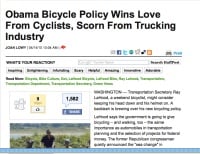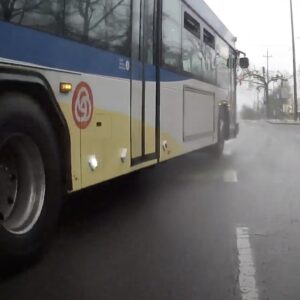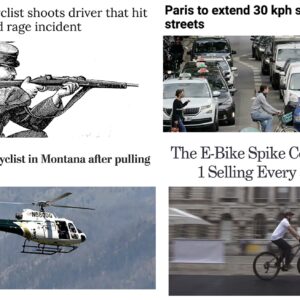
An Associated Press story about US DOT Secretary Ray LaHood that’s making rounds on the Internet today (it’s running on Huffington Post and BusinessWeek.com just to name a few) says there’s “A backlash is brewing over his new bicycling policy.”
There might be a backlash from some who still don’t get it, but at least one voice of the trucking industry still thinks LaHood is great — bike policy and all.
The policy is question is LaHood’s recent proclamation that the Obama Administration will preside over the “end of favoring motorized transportation” over non-motorized modes.
It’s not surprising LaHood’s statements — especially on the heels of a DOT Secretary that didn’t even think bikeways should be considered transportation infrastructure — would ruffle some feathers. Here’s a snip from the AP story:
“The National Association of Manufacturers’ blog, Shopfloor.org, called the policy “dumb and irresponsible.”
“LaHood’s pedal parity is nonsensical for a modern industrial nation,”
…At a recent House hearing, Rep. Steve LaTourette, R-Ohio, suggested jokingly to a Transportation Department official that one explanation for the new policy is that the secretary’s thinking has been clouded by drugs.
“Is that a typo?” LaTourette asked. “If it’s not a typo, is there still mandatory drug testing at the department?”
Unfortunately, what the AP writer didn’t mention is that America’s Trucking Newspaper, The Trucker, likes Mr. LaHood. The editor of that paper, Lyndon Finney, wrote an article after LaHood’s Bike Summit speech saying, “We like Ray LaHood.”
Finney gets it. He wrote that to “safely deliver those bicycles to ride over those new bike paths” highways and roads — the same highways and roads truckers use — must be available and in good condition.
Here’s the conclusion of Finney’s article:
“Don’t be surprised if someday you look up and see Ray LaHood beside a new highway, a new bike path, a new airport runway, a new walking trail in your community, peering down over those glasses, expounding on his passion for transportation.
We like Ray.”
We’ve heard all the anti-bike talking points many times before. But now, with the top transportation official in America saying the right things, those trash talkers seem to have a lot less power than they used to. It’s hardly time for bike advocates to despair. In fact, now is the time that LaHood and members of Congress need to hear that the American public has got their back on this. On that note, now would be a good time to head over to PeopleForBikes.org and make your voice heard.





You should check out Tennessee congressional candidate Kerry Roberts (www.kerryroberts.com), currently running for congress in Tennessee’s 6th district, which includes a lot of Nashville suburbs.
Roberts owns two bike shops and is former president of and former chairman of the National Bicycle Dealers Association.
You can follow him on Twitter at http://www.twitter.com/kerryeroberts
It seems a growing number of Americans support the 20-min community concept and even those who are hesitant to focus on non-motorized transportation tend to prefer living in walkable neighborhoods.
The fact that there is resistance to the idea is by itself almost meaningless. After all, how many papers and persons resisted banning slavery or even the first “good roads” movement back when cars were still sci-fi stuff.
Cyclists have more in common with truckers than a first glance would tell. It was bicyclists in the first place that got together and organized the original good roads movement to improve roadways between urban areas. And like Marcus (#1)referenced, people like living in neighborhoods where the basic business like grocery stores are within a 20 minute walk. Those type of walkable neighborhoods are only possible with the support of a very effective trucking system to get goods to the neighborhood stores.
If you want to have all of those little stores around your neighborhood to walk to than you better fix CRC so those trucks can get to those stores
#4:
Freight comes over rail. The trucking industry has seen fuel costs stiffeling their bussiness so they are quite prepared to go fully intermodal picking up cross country freight from the local rail depot. There is one in Portland AND Vancouver so any argument that we NEED NEED NEED a new CRC for freight is bunk.
jim – “fix” CRC would be removing it entirely and simply updating the bridge for seismic standards, as well as adding a 2nd rail bridge at the western end of Hayden Island. Long-range freight is more economical by train. The trucks going to “the little stores” are, well – little trucks, bringing stuff in that’s local, or from a local distribution center. The big trucks coming into and through Portland are mostly for big-box retailers with giant regional distro centers. Now, we could argue whether they matter in the larger scheme of things in Portland proper, but many of them are bypassing Portland and taking I-205. Those that aren’t are frequently running at night, which is not congested. Those that run during the day are not going to be helped by CRC – CRC will increase traffic, increase congestion, and reduce average truck speeds.
There was a great documentary years back called “Subdivide and Conquer,” about suburban sprawl in the American West. In this movie there was a scene at a workshop in which people were given butcher paper and markers, and were allowed to conceptualize their ideal neighborhoods. What they tended to come up with were classic American pre-war neighborhoods: cozy but not crowded; walkable, and – just as importantly – with places to walk to, i.e. nearby commercial streets; and very livable. Quiet, tree-lined places, but not sprawled-out and car-dependent.
The appeal of that kind of neighborhood dovetails nicely into the emerging idea of the 20-minute neighborhood, and also into a sense of place that is deeply, and traditionally American. Places like that are great to walk and bike in, and should also have the support of conservative traditionalists. The ones who don’t let political point-scoring determine their every move, anyway. Some of these guys seem like they’d starve if this administration announced that it was in favor of food.
Trucks can get where they’re going faster if there are less cars on the road…
Kt #8, your comment reminds me (in a good way) of a shirt that a Seattle bike store used to sell; the slogan printed on the back was “One More Parking Space.”
jim #4:
Freight makes up only 8% of the traffic going over the Columbia. When freight is blocked on those bridges, it’s blocked mainly by commuter traffic, and to a lesser extent traffic going to big-box stores on Hayden Island. (An island with a big shopping center, and only one way on or off it. And that one way is onto a busy freeway. How crazy is that?)
When we’re talking about congestion, it’s the traffic that’s the problem, not the bridges. (The bridges definitely need to be seismically upgraded, but not necessarily replaced.)
The traffic could be addressed in part by putting a local bridge to Hayden, so shoppers and residents could have access without having to brave I-5 interchanges.
The turbulence caused by on-ramp /off-ramp traffic alone is probably a huge contributor to the current traffic jams.
And of course freight could be brought in more via rail, as others have said.
While we’re at it, fixing that rail bridge downstream would provide a huge benefit to barge traffic, and prevent bridge lifts on I-5 (see this video for a great description of the “S-Curve” problem http://vimeo.com/5419575).
Anyway, I continue to be fascinated by that issue of turbulence cause by the Hayden Island on/off ramp traffic.
Take a look at this image:
http://farm5.static.flickr.com/4053/4521754228_ba165081eb_o.jpg
This is of two maps from Google Map’s traffic view. Google Maps lets you enter in days and times, and see typical traffic volumes at certain times of day.
The image shows the differences in traffic volume between the worst examples I could find of the typical Wednesday morning commute going south over the Columbia, and the worst of the typical Wednesday evening commute going north. The traffic jam going north is several times larger than the one going south! That seems odd to me.
It seems reasonable to assume that a big part of the difference in traffic jam sizes has to be that turbulence caused by big-box store traffic. People aren’t hitting those stores at 7:45 am, but they’re doing it in the evening.
That kind of turbulence can cause a ripple effect that can go on for miles.
Whoops, I broke the link to the S-Curve video there. Try this:
http://vimeo.com/5419575
Spencer, i think your on the right track here. I can’t watch the video cause I’ve got a dino of a computer.
Getting back to the 20 min neighborhood, Its always interesting to me that talking to people i love and respect(who are in the burbs and the city) that they would favor just walking or liesurely riding a bicycle to the butcher the baker and the cafe maker, but can only accept it when they go to the E.U. and then fall back in to the lull of cars, freeways, and malls, when they come back.
I guess we need to take the political aspects out of everyday life and realize were all on the same side, That might sound silly, kinda of is I guess. I just don’t understand that the nation that thinks it can do anything, doesn’t think anything is possible anymore.
Cheers, tony
Spencer (#7): Those ‘Euro-style’ neighborhoods have shown to be the valuable real estate. I’ve noticed a huge disparity in “20-minute ‘hoods” though. The wealthier ones are walkable, have upscale markets with lots of choices, and parking is a huge pain. People want to live in these hoods now because they are already gentrified. In the average hood where lots of parking is available (generally due to lower land costs) people drive to shops that may only be a few hundred feet away. I’ve seen ridiculous examples of this behavior living in Santa Clara, Sunnyvale, and Beaverton. I walked to Safeway as my next-door neighbor offered me a ride. I beat him into the door as it took him a little while to maneuver stop signs and park (for only one small bag of groceries; he didn’t buy in bulk because the store is so close).
My GF lives in an apartment in a nice hood in Menlo Park and people love to walk and bike there. They’ll walk from miles around on a sunny weekend to the farmer’s market. Getting around by car is a huge PITA there. I think there’s a distinct correlation, and my opinion is that for the most part people will be as lazy as they possibly can be. We see this also in the numbers of people biking to work when gas prices get outrageously high (money=work after all).